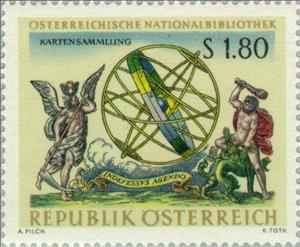Stamp: Celestial sphere with the God Chronos & Heracles (Austria 1966)
Celestial sphere with the God Chronos & Heracles (Austria 1966)
28 September (Austria ) within release National Library goes into circulation Stamp Celestial sphere with the God Chronos & Heracles face value 1.80 Austrian schilling
| Stamp Celestial sphere with the God Chronos & Heracles in catalogues | |
|---|---|
| Michel: | Mi:AT 1219 |
| Stamp Number: | Sn:AT 774 |
| Yvert et Tellier: | Yt:AT 1055 |
| Stanley Gibbons: | Sg:AT 1481 |
| Unificato: | Un:AT 1055 |
Stamp is horizontal format.
Also in the issue National Library:
- Stamp - Figures & decoration of the Roman comedy "Eunuchus" face value 1.50;
- Stamp - Celestial sphere with the God Chronos & Heracles face value 1.80;
- Stamp - Ancient country home in Vienna, by Anton Stutzinger face value 2.20;
- Stamp - Illustration from the book "Buch vom liebentbrannten Herzen" face value 3;
Stamp Celestial sphere with the God Chronos & Heracles it reflects the thematic directions:
Myth is a genre of folklore consisting primarily of narratives that play a fundamental role in a society. For scholars, this is very different from the vernacular usage of the term "myth" that refers to a belief that is not true. Instead, the veracity of a myth is not a defining criterion
A map is a symbolic depiction emphasizing relationships between elements of some space, such as objects, regions, or themes. Many maps are static, fixed to paper or some other durable medium, while others are dynamic or interactive. Although most commonly used to depict geography, maps may represent any space, real or imagined, without regard to context or scale, such as in brain mapping, DNA mapping, or computer network topology mapping. The space being mapped may be two dimensional, such as the surface of the earth, three dimensional, such as the interior of the earth, or even more abstract spaces of any dimension, such as arise in modeling phenomena having many independent variables. Although the earliest maps known are of the heavens, geographic maps of territory have a very long tradition and exist from ancient times. The word "map" comes from the medieval Latin Mappa mundi, wherein mappa meant napkin or cloth and mundi the world. Thus, "map" became the shortened term referring to a two-dimensional representation of the surface of the world.
Drawing is a visual art that uses an instrument to mark paper or another two-dimensional surface. The instrument might be pencils, crayons, pens with inks, brushes with paints, or combinations of these, and in more modern times, computer styluses with graphics tablets.
Outer space (or simply space) is the expanse that exists beyond Earth's atmosphere and between celestial bodies. It contains ultra-low levels of particle densities, constituting a near-perfect vacuum of predominantly hydrogen and helium plasma, permeated by electromagnetic radiation, cosmic rays, neutrinos, magnetic fields and dust. The baseline temperature of outer space, as set by the background radiation from the Big Bang, is 2.7 kelvins (−270 °C; −455 °F)




